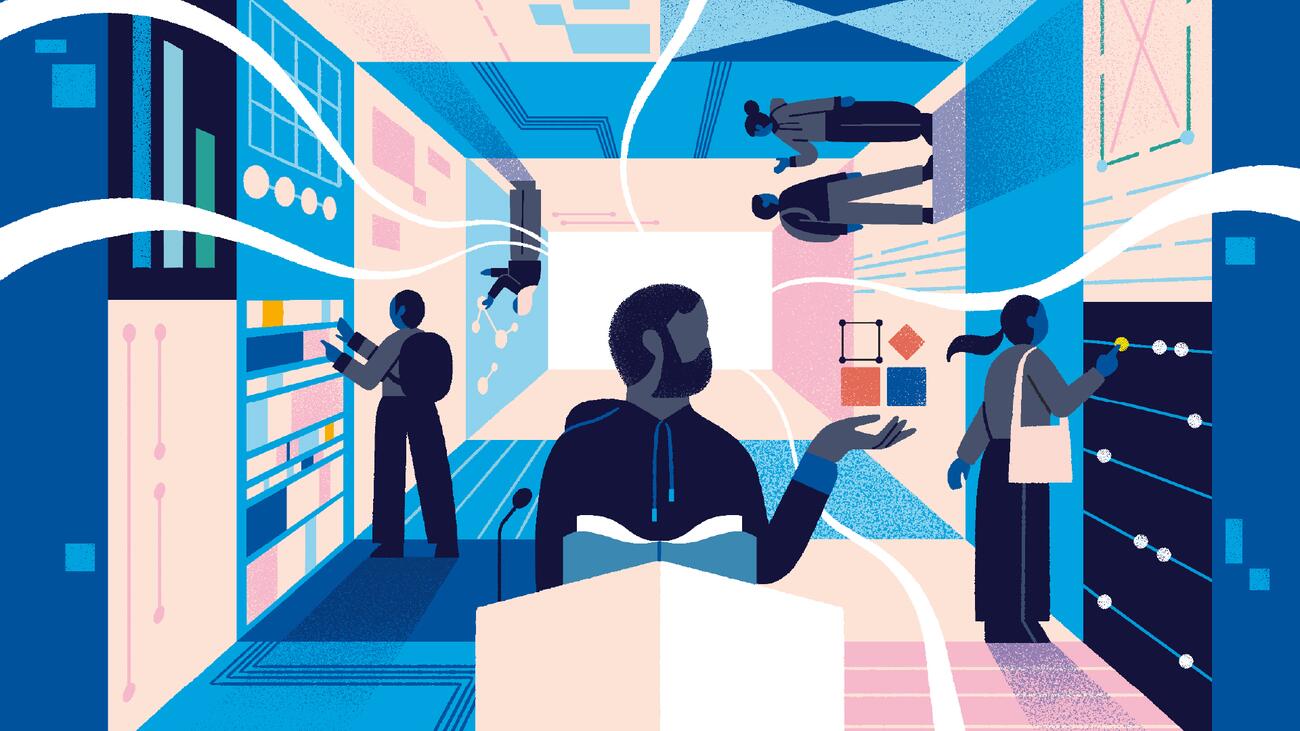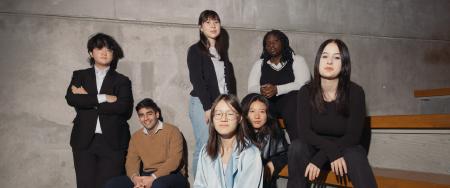
Illustration by Beatrix Hatcher
Democratizing the lectern
Today’s students are not passive recipients of knowledge. They are active participants in their own education.
Any well-creased academic will tell you that changes in pedagogy move at a glacial pace. For thousands of years, students have learned by sitting at the feet of a master – chiseling, writing, or typing notes into a tablet – memorizing facts in the hope that they may, one day, find themselves on the power side of the lectern. There was a brief moment in ancient Greece when someone suggested replacing monologues with dialogues, but the conversation did not end well for him.
Is this a gross oversimplification? Yes. Is it really that far from the truth? No.
There have, of course, been teachers and schools over the years that valued interaction over the lecture method. But only in the current century have practices arisen like the “flipped classroom,” “cooperative exams,” and “ungrading.” These methods empower students to shape their own curricula, collaboratively tackle real-world problems, and receive continuous feedback rather than letter grades – turning traditional education spaces into laboratories for student-led learning.
“We have a lot of faculty at UBC Okanagan who are taking a scholarly approach to their teaching,” says Peter Arthur, founding director of the Centre for Teaching and Learning at UBC’s Okanagan campus. “So that’s delving in, consulting the literature, and using evidence-based practice. They’re asking, ‘What does the research say about how students learn best, and consequently, how can I best teach?’”
In this environment, the curriculum places less emphasis on memorizing facts and more on critical thinking and problem-solving, bringing about more interactive, hands-on, and student-centered approaches to teaching and learning. Instead of passive receivers of knowledge, students are becoming partners in its creation.
Seen through the eyes of a generation that grew up surrounded by the greatest expansion of technology and “interconnectedness” in human history, this shouldn’t be a surprise. The modern student has the world at their fingertips – no longer an empty bucket to be filled by a guru, they have gained some control over the spigot. “The teacher role has changed from ‘holder of knowledge’ to ‘facilitator of learning,’ which is very different,” adds Arthur. “Instead of the instructor being the sage on the stage, they are the guide on the side.”
In a sense, this is a democratization of the lectern. The digital age has given Gen Z broader access to other perspectives and unparalleled control over their own voices compared with previous generations of learners, so they come into the classroom with expectations of teaching methods that give them a sense of responsibility for their world and their place in it.
The modern student has the world at their fingertips – no longer an empty bucket to be filled by a guru, they have gained some control over the spigot.
“Most of these initiatives like flipped classrooms were in progress long before Gen Z,” says Celeste Leander, professor of teaching in the departments of Botany and Zoology in the Faculty of Science. “What I noticed immediately with Gen Z is that they tend to be less tech-focused (ie, don’t need to have the latest phone), are concerned about their world in a proactive way, and are engaged. I think their collective, relatively responsible nature makes things like ungrading easier.”
On the ground, this plays out as a move from lecture-based learning to project-based learning, where students actively solve real-world problems or explore real-world questions, often working in teams, integrating multiple subjects, and learning their tools as they go.
So how do teachers assign grades in these complex and interconnected team environments? Often they don’t.
“The minute there’s a point or a grade attached to something, that’s what students focus on,” adds Leander. “Why did I get this point off? What’s my grade? And that’s what they’re after, rather than being internally motivated by learning the thing that they’re there to learn.
“Traditional ways of grading don’t measure what we think they’re measuring, and they don’t necessarily promote learning in the way that we think that they do. The community of educators is venturing away from the traditional sit in a seat, take an exam method, and moving into more of a student-based participation in their assessment. I think it gives students a lot of power back. They feel like they have agency in their own educational journey, which I think is important.”
Leander is five semesters into her self-grading experiment for her 3rd-year course Integrative Biology Laboratory, which she changed when students returned to classrooms after the pandemic. Most had been learning online for the previous two years and had never set foot in a college lab, so she wanted to give them “a safe place to land” by letting them evaluate their own work and assign themselves a grade based on a thoroughly written self-evaluation.
That evaluation is now a 25-page course reflection. Each student has to go through each of their class projects in detail, evaluating what they could improve, what they learned, and what they did well, then suggesting the grade they should receive for the course.
The pedagogy is centered around these self-evaluated projects, which this semester include studying environmental conditions in a salmon stream, writing a report for the City of Vancouver, conducting a seafood forensics investigation, authoring a detailed paper on their research procedures, and creating a team project from scratch and writing their results in a course journal.
Although Leander discusses grade suggestions with students who may be missing the mark, she has found the students pretty fair with themselves – and happier with the class. “They say that they’re more motivated to learn without grades,” says Leander. “They say that they work harder, which we do think is true.”
For a host of reasons, there will still be the need for some form of quantitative evaluation of students, whether it comes in the form of traditional standards-based testing, self-assigned grades, or competency evaluations. But just as we downloaded penmanship tasks to the typewriter and math tasks to the calculator, we are on the cusp of downloading memorized data to artificial intelligence for storage and synthesis, freeing us to spend more time flexing our higher thinking skills – and, of course, learning these new tools.
“Do we really need students to learn how to memorize X, Y, and Z?” asks Arthur. “Or do we need them to be able to find X, Y, and Z and apply it in an authentic way? Because after we credential them and they’re out in the real world, they’re going to continually need to learn how to learn because their context will constantly be changing. They need to be lifelong learners. So we need to prepare them for that.”




































